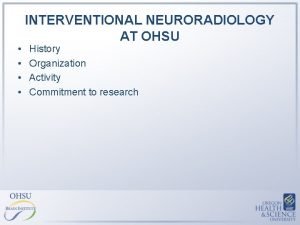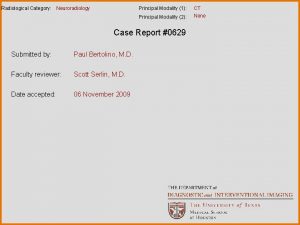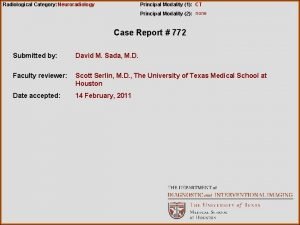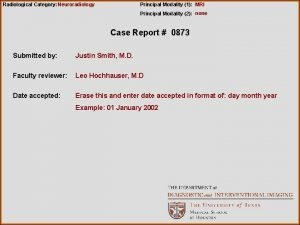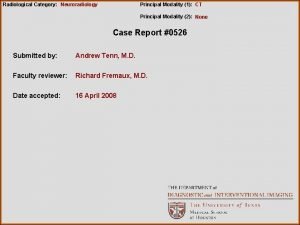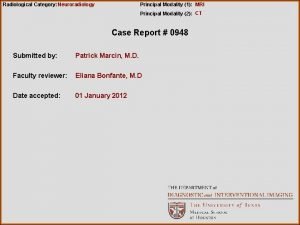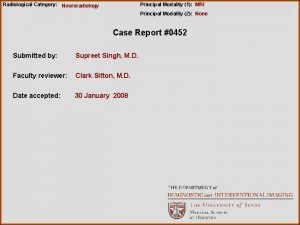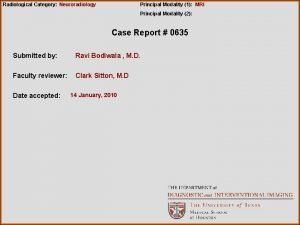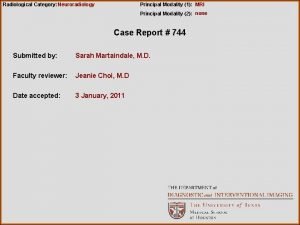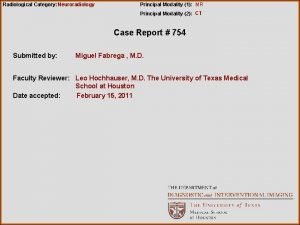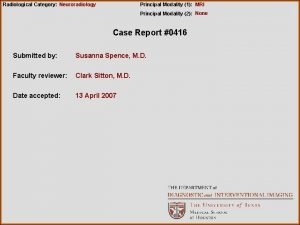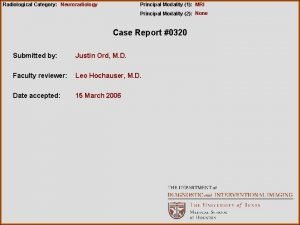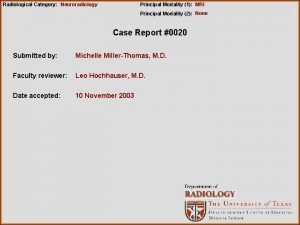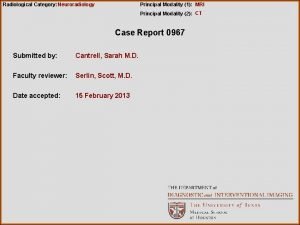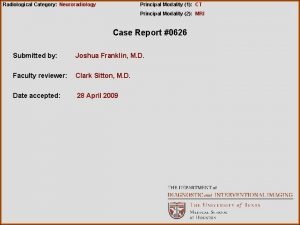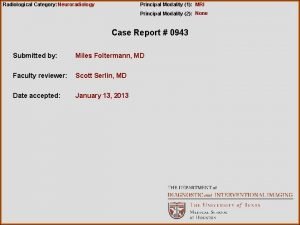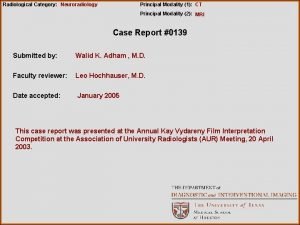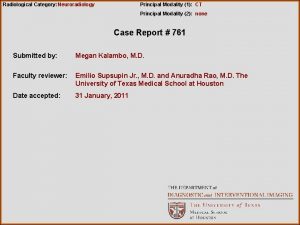Radiological Category Neuroradiology Principal Modality 1 CT Principal



















![References 1. Ramnani D. Cat Scratch Disease: Warthin-Starry Stain [Internet]. Richmond (VA): VUC Pathology References 1. Ramnani D. Cat Scratch Disease: Warthin-Starry Stain [Internet]. Richmond (VA): VUC Pathology](https://slidetodoc.com/presentation_image/155f99303b0691396d17037ec74251e1/image-20.jpg)
- Slides: 20

Radiological Category: Neuroradiology Principal Modality (1): CT Principal Modality (2): None Case Report 706 Submitted by: Miles Foltermann, MD Faculty reviewer: Jeanie Choi, MD The University of Texas Medical School at Houston Date accepted: 12 April 2010

Case History A 2 -year-old girl presents with a 6 -week history of painful, progressively enlarging bilateral neck masses. The patient also has intermittent fever, headache, and fatigue. The remaining history is withheld.

Radiological Presentations Coronal contrast-enhanced CT

Radiological Presentations Coronal contrast-enhanced CT

Radiological Presentations Coronal contrast-enhanced CT

Radiological Presentations Axial contrast-enhanced CT

Radiological Presentations Axial contrast-enhanced CT

Radiological Presentations Axial contrast-enhanced CT

Radiological Presentations Axial contrast-enhanced CT

Test Your Diagnosis Which one of the following is your choice for the appropriate diagnosis? After your selection, go to next page. • Lymphoma • Infected branchial cleft cysts • Cat scratch disease • Lymphatic malformation • Lymphadenitis (e. g. , bacterial infection) • Mycobacterial infection/Tuberculosis

Findings: An ill-defined multiloculated cystic mass abuts the carotid space in the right neck. There is associated anteromedial displacement of the parapharyngeal fat and medial displacement of the carotid arteries and internal jugular vein. Minimal stranding is seen in the overlying subcutaneous fat, but much of the adjacent fat is normal. A smaller cystic mass is noted in the left retromandibular area. Several bilateral, solid appearing, homogeneously enhancing lymph nodes are also present. The vallecula, epiglottis, and aryepiglottic folds are normal.

Differentials • Lymphoma • Infected branchial cleft cysts • Cat scratch disease • Lymphatic malformation • Lymphadenitis (e. g. , bacterial infection) • Mycobacterial infection/Tuberculosis

Discussion The causative agent in cat scratch disease is Bartonella henselae, a curved, pleomorphic, gram-negative bacillus. Infection is self-limiting, and prognosis is excellent. More than 90 percent of patients with cat scratch disease report recent contact with a cat. In 90 percent of cases, an incubation period of 3 to 14 days is followed by the development of cutaneous papules or pustules at the site of inoculation. The primary lesion lasts for 1 to 3 weeks, then disappears. Regional lymphadenopathy then ensues, generally just proximal to the site of inoculation. Fig. 1. Warthin. Starry stain of Bartonella henselae. Ramnani (1) with permission

Discussion Regional lymphadenopathy is the typical complaint that prompts medical evaluation. Lymphadenopathy most commonly involves the axillary nodes, though cervical and inguinal involvement are also common. Lymph nodes are often painful, and they spontaneously suppurate in 25 to 30 percent of cases. Constitutional symptoms are usually mild: malaise, low-grade fever, anorexia, nausea, fatigue, and headache.

Discussion CT imaging of classic cat scratch disease shows lymph node enlargement with extensive surrounding edema in the distribution of the lymphatic drainage proximal to the inoculation site. Nodes may also demonstrate heterogeneous attenuation or central low attenuation, reflective of central necrosis. An important differential consideration is lymphoma. These patients typically present with painless, rubbery lymph nodes, which may be located in the neck. B symptoms (fever, nights sweats, weight loss) may also be present. On CT imaging, there may be homogeneous, lobulated nodes, necrotic nodes, or both. History is important in differentiating these two etiologies, since there may be morphologic overlap on imaging.

Discussion Second branchial cleft cysts represent remnants of the branchial cleft apparatus. They are low density, typically non-loculated, and have no discernible wall unless they are infected. They can occur anywhere between the tonsillar fossa and the supraclavicular region. However, the characteristic location for a branchial cleft cyst is posterolateral to the submandibular gland, lateral to the carotid space, and anteromedial to the sternocleidomastoid muscle. Only 2 -3% are bilateral. In the present case, the bilateral cystic masses exhibited this configuration. However, they were bilateral and multiloculated. * Fig. 4. In the present case, bilateral multiloculated cystic masses cause medial displacement of the carotid space structures (arrow). These masses are posterior to the submandibular glands (*) and anterior to the sternocleidomastoids (+). * +

Discussion Mycobacterial infection may also cause lymphadenopathy within the neck. Specifically, atypical mycobacteria may cause centrally hypoattenuating nodes with little surrounding reaction. Again, history is an important factor. In immunocompromised children or children with exposure history, mycobacterial lymphadenitis should be higher in the differential diagnosis. Lymphatic malformations are thought to represent abnormally developed lymphatic sacs and channels. They present as cystic masses (uniloculated or multiloculated) that interpolate between normal structures in the neck, without exerting significant mass effect. In the absence of infection they have imperceptible walls.

Discussion Upon further questioning, it was determined that the patient in the present case was scratched on the arms by a stray cat just prior to the onset of symptoms. Her clinical condition improved after bilateral abscess drainage and antibiotic therapy.

Diagnosis Cat scratch lymphadenitis.
![References 1 Ramnani D Cat Scratch Disease WarthinStarry Stain Internet Richmond VA VUC Pathology References 1. Ramnani D. Cat Scratch Disease: Warthin-Starry Stain [Internet]. Richmond (VA): VUC Pathology](https://slidetodoc.com/presentation_image/155f99303b0691396d17037ec74251e1/image-20.jpg)
References 1. Ramnani D. Cat Scratch Disease: Warthin-Starry Stain [Internet]. Richmond (VA): VUC Pathology Laboratory; 2008 Jan 1 [updated 2009 Oct 13; cited 2010 Mar 20]. Available from http: //webpathology. com/image. asp? case=386&n=4. 2. Binnick AN and Habif. Cat Scratch Fever [Internet]. Dartmouth (NH): Dartmouth Medical School; 2009 Jan 1 [updated 10 Dec 2009; cited 2010 Mar 20]. Available from http: //www. lib. uiowa. edu/ha. RDIN/MD/dermnet/catscratch. html. 3. Dong PR, Seeger LL, Yao L, Panosian CB, Johnson BL Jr, Eckardt JJ. Uncomplicated cat scratch disease: findings at CT, MR imaging, and radiography. Radiology. 1995 Jun; 195: 837 -9. 4. Turkington A, Paterson A, Sweeney LE, Thornbury GD. Neck masses in children. BJR. 2005; 78: 75 -85. 5. Wetmore RF, Mahboubi S, Soyupak SK. Computed tomography in the evaluation of pediatric neck infections. Otolaryngol Head Neck Surg. 1998 Dec; 119(6): 624 -7.
 Ohsu neuroradiology
Ohsu neuroradiology Erate category 2 eligible equipment
Erate category 2 eligible equipment Radiological dispersal device
Radiological dispersal device Tennessee division of radiological health
Tennessee division of radiological health Center for devices and radiological health
Center for devices and radiological health National radiological emergency preparedness conference
National radiological emergency preparedness conference Sodality vs modality
Sodality vs modality Cardinality and modality
Cardinality and modality Epistemic modality
Epistemic modality Modality erd
Modality erd Modality in software engineering
Modality in software engineering Data modeling fundamentals
Data modeling fundamentals Birads score
Birads score Pacs modality workstation
Pacs modality workstation Past tense in xhosa
Past tense in xhosa Modality in software engineering
Modality in software engineering Sensory vs somatic
Sensory vs somatic Deontic modality
Deontic modality Modality in software engineering
Modality in software engineering Cardinality and modality
Cardinality and modality Lexical vs auxiliary verbs
Lexical vs auxiliary verbs
